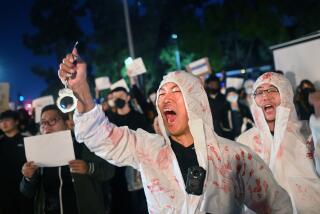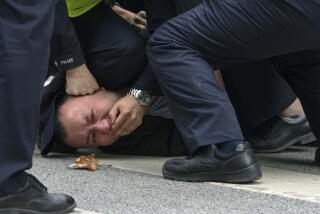10 reported dead in Tibet rioting
- Share via
BEIJING — Tibet was hit by a fresh wave of violence Friday as protests by hundreds of Buddhist monks and other residents against Chinese rule resulted in burned shops, vandalized police vehicles and at least 10 deaths, government officials and witnesses said.
American citizens in Lhasa, the capital of Tibet, reported rioting and gunfire, the U.S. Embassy in Beijing said in a warning to stay away from the city, which has seen several days of anti-Chinese protests.
“All care should be taken to avoid unnecessary movement within the city until the situation is under control,” the alert said.
“Americans who were planning on travel to Tibet are advised to defer travel at this time.”
The official New China News Agency reported today that 10 people had died in the violence. It said the victims, including two hotel workers and two shop owners, had been “burnt to death.”
“We didn’t dare to step out. Those Tibetan people were beating any Han Chinese they meet,” said a Chinese tour operator today who did not wish to give his name. He also said calm was beginning to return, but two sections of the city were still tightly controlled by Chinese security forces.
Among the establishments set on fire were a bank, a supermarket and the Lhasa bureau of the New China News Agency, said the Hong Kong-based newspaper Apple Daily.
Tibetan radio reported Friday that a curfew had been imposed. Armed police reportedly used water cannons and tear gas on the crowds.
“There’s smoke and flames coming from the old city, but I can’t tell what’s going on since soldiers have surrounded the area,” said one Lhasa resident by telephone, who declined to be identified because of fear of repercussions.
A tour guide surnamed Zhu, who wouldn’t give his first name, said there was a police and military crackdown underway, particularly in the area around Jokhang Temple. He said he could see dozens of military vehicles.
Tibet is among the most tightly controlled areas in China. Protests first flared March 10, when monks took to the streets to mark the anniversary of a 1959 Tibetan uprising against Chinese rule. Communist Chinese troops seized control of Tibet in 1950.
China is nervous about challenges to its single-party rule at a time when its human rights record is under growing global scrutiny ahead of the Aug. 8-24 Beijing Olympics.
The government wants to control its public image but faces challenges presented by modern technology. As a result of the protests, blogs lighted up with witness accounts, speculation and opinion as photos and video were uploaded and made available around the world.
“Police cars and fire engines were outside smashed and burned,” wrote a blogger from Lhasa under the name Beifang. “A lot of Tibetans ran towards Dazhao [Jokhang] Temple. I heard gunshots. Five army police vehicles drove that way. A large number of armed police followed. A few people with blood on their faces were taken away.”
White House spokesman Gordon Johndroe called on Beijing to respect Tibetan culture and said President Bush had long urged China to talk with the Dalai Lama, the exiled Tibetan spiritual leader Beijing condemns as a “splittist.”
The European Union and numerous human rights groups also urged China to show restraint, while sympathy protests reportedly broke out in New Delhi; Katmandu, Nepal; the United Nations; and in the western Chinese province of Gansu.
In a statement, the Dalai Lama urged restraint on all sides but said the protests were a “manifestation of the deep-rooted resentment of the Tibetan people.”
China has blamed the disturbances on followers of the Dalai Lama, whom the regime has accused of trying to sabotage the Beijing Olympics.
Information restrictions made it difficult to determine how many people were involved in the protests. Some reports put the number at 1,000, including stone throwers and people hurling concrete chunks at authorities, with Han Chinese-owned stores reportedly a particular target of arsonists.
Tibetans said protests had taken place at the three major monasteries of Sera, Drepung and Ganden. There have also been reports from Amdo province, the birthplace of the Dalai Lama.
Some observers described the protests as the largest against Chinese rule since the Tiananmen Square demonstrations in 1989.
Analysts said that the monk-led protests earlier in the week were tactical and carefully aimed less at provoking the state than nudging it to address their concerns. Chinese authorities kept many of the monks away from large population centers without being too heavy-handed, an effective strategy, analysts said.
On Friday morning, however, things apparently got out of control when a massive police force showed up against a relatively small temple protest inside the city center.
This angered laypeople, who jumped to defend the monks, prompting the police to retreat and allow the anti-government crowd to start venting its anger against Chinese-run shops.
--
--
Times staff writer Barbara Demick contributed to this report.
--
(BEGIN TEXT OF INFOBOX)
Back story
Tibet sits on a high, sparsely populated plateau, with the Himalayan mountain range to the south. The Chinese People’s Liberation Army marched into the region in 1950, and the Dalai Lama, revered as Tibet’s god-king by his followers, fled after a failed uprising against Chinese rule in 1959. China has long accused the 72-year-old spiritual leader of seeking independence for Tibet. Critics of Beijing say Buddhist monks and nuns loyal to the Dalai Lama have been jailed and tortured over the years by the Chinese.
--
Source: Associated Press
More to Read
Sign up for Essential California
The most important California stories and recommendations in your inbox every morning.
You may occasionally receive promotional content from the Los Angeles Times.










